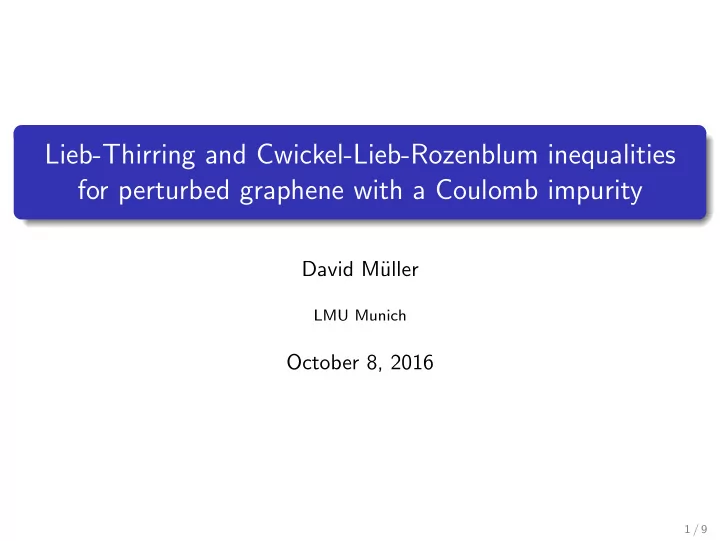

Lieb-Thirring and Cwickel-Lieb-Rozenblum inequalities for perturbed graphene with a Coulomb impurity David M¨ uller LMU Munich October 8, 2016 1 / 9
Reference Collaborator This talk is based on joint results with Sergey Morozov (LMU Munich). Preprints The results presented in this talk can be found in two recent preprints on arXiv. 2 / 9
Graphene Structure Graphene is a single atomic layer of graphite, in which carbon atoms are arranged in a honeycomb lattice. 3 / 9
Graphene Zero gap semiconductor The dispersion surfaces of the fully occupied valence and totally empty conduction bands touch at conical (Dirac) points. (Wallace 1947, Fef- ferman, Weinstein 2012) 4 / 9
The Coulomb-Dirac operator Energy dispersion relation near the conical points � � 0 � � 0 � � 1 − i − i � v F σ · ∇ with σ = ( σ 1 , σ 2 ) = , 1 0 i 0 Here v F ≈ 10 6 m / s is the Fermi velocity. We choose units with � v F = 1. Impurity Suppose now that the graphene sheet contains an attractive Coulomb impurity of strength ν . The effective Hamiltonian is then given by − i σ · ∇ − ν | x | − 1 . For ν ∈ [0 , 1 / 2] there exists a distinguished self-adjoint realization D ν of this differential expression. 5 / 9
The model State space Since the Fermi energy is zero, the space of physically available states is P + ν L 2 ( R 2 ; C 2 ), where P + ν is the spectral projector of D ν to [0 , ∞ ). Perturbed Coulomb-Dirac operator in the Furry picture Consider an external potential V given by a Hermitian matrix-valued function. If it is not strong enough to substantially modify the Dirac sea, the perturbed effective Hamiltonian takes the form D ν ( V ) := P + ν ( D ν − V ) P + ν . Bound states The negative spectrum of D ν ( V ) may only consist of eigenvalues, which can be interpreted as bound states of a quantum dot. Here we prove estimates on these eigenvalues. 6 / 9
Results Theorem 1 - Cwikel-Lieb-Rozenblum inequalities Let ν ∈ [0 , 1 / 2). There exists C CLR > 0 such that ν � � � � � 2 d x . − � C CLR rank D ν ( V ) R 2 tr V + ( x ) ν Theorem 2 - Virtual level at zero Let � 2 π � � − i V 12 ( r , ϕ ) e i ϕ V ( r ) := 1 V 11 ( r , ϕ ) � d ϕ. i V 21 ( r , ϕ ) e − i ϕ V 11 ( r , ϕ ) 2 π 0 Suppose that � ∞ �� − 1 � � − 1 �� V � C 2 × 2 ∈ L 1 � � � � , � R + , (1 + r 2 ) d r and V ( r ) C 2 d r > 0 . 1 1 0 Then the negative spectrum of D 1 / 2 ( V ) is non-empty. 7 / 9
Results Theorem 3 - Lieb-Thirring inequalities Let ν ∈ [0 , 1 / 2] and γ > 0. There exists C LT ν,γ > 0 such that � � � γ � � 2+ γ d x . − � C LT tr D ν ( V ) R 2 tr V + ( x ) ν,γ Remark For ν = 1 / 2 the inequality in Theorem 3 is a Hardy-Lieb-Thirring inequality. 8 / 9
Proofs of Theorems 1 and 3 Theorem 4 For every ν ∈ [0 , 1 / 2) there exists C ν > 0 such that √ | D ν | � C ν − ∆ ⊗ ✶ 2 (1) holds. For any λ ∈ [0 , 1) there exists K λ > 0 such that � K λ ℓ λ − 1 ( − ∆) λ/ 2 − ℓ − 1 � | D 1 / 2 | � ⊗ ✶ 2 (2) holds for any ℓ > 0. 9 / 9
Thank you for your attention!
Recommend
More recommend